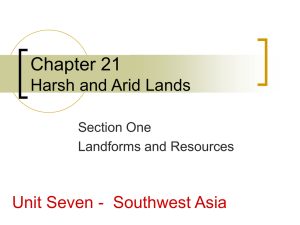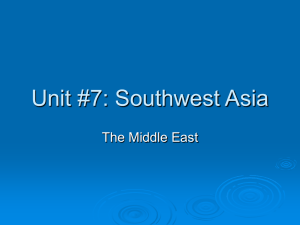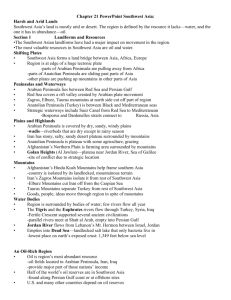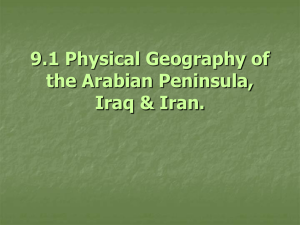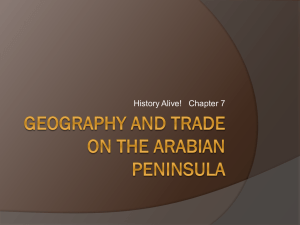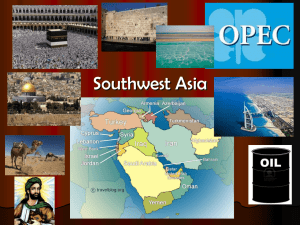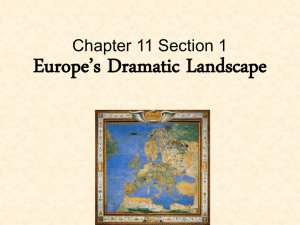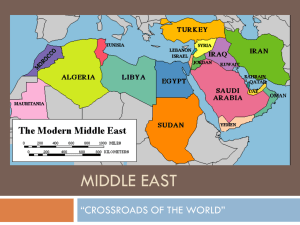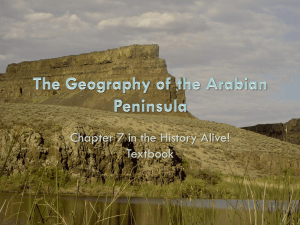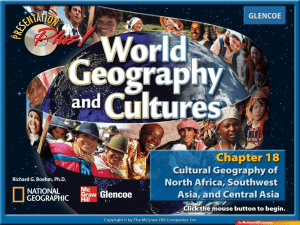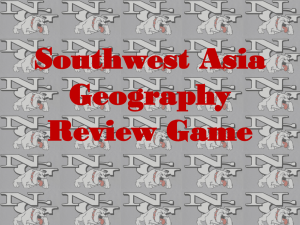- OTHS World Geography
advertisement
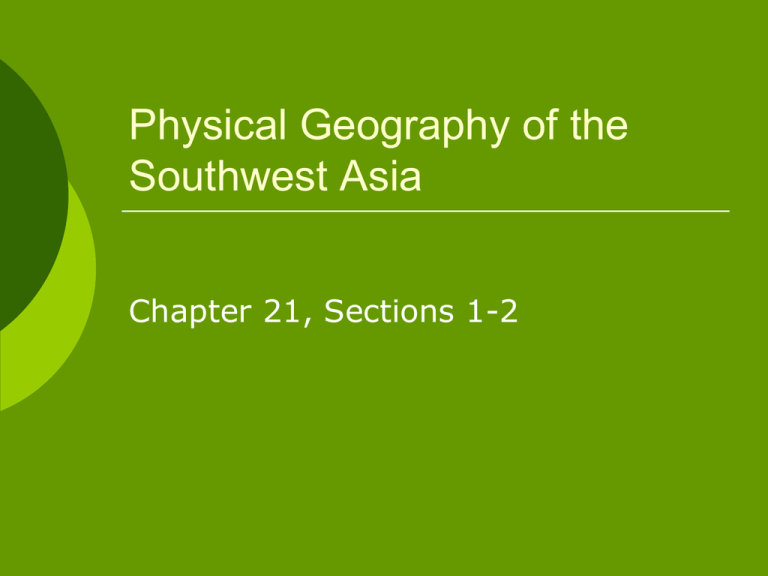
Physical Geography of the Southwest Asia Chapter 21, Sections 1-2 Objectives Identify and examine different features of the Southwest Asia’s and North Africa’s physical geography. Explain the different types of climates and vegetations. Describe the region’s key resources. The Middle What? Why do we refer to Southwest Asia as “The Middle East?” Southwestern Asian Countries and Capitals Afghanistan: Kabul Bahrain: Manama Cyprus: Nicosia Iran: Tehran Iraq: Baghdad Israel: Jerusalem Jordan: Amman Kuwait: Kuwait City Lebanon: Beirut Oman: Muscat Qatar: Doha Saudi Arabia: Riyadh Syria: Damascus Turkey: Ankara United Arab Emirates: Abu Dhabi Yemen: Sanaa http://www.list.org/~mdoyle/Middle_East_pol97.jpg Southwest Asia Subregions How many cultural sub regions are there? Three Arabian Peninsula Eastern Mediterranean Northeast Cultural Subregions Overview Arabian Peninsula Saudi Arabia, United Arab Emirates, Qatar, Kuwait, Oman, Yemen, Bahrain Cultural Subregions Overview Eastern Mediterranean Cyprus, Lebanon, Israel, Syria, Jordan Cultural Subregions Overview Northeast Turkey, Iran, Iraq, Afghanistan The Arabian Peninsula The Arabian Peninsula What three continents surround the Arabian Peninsula? Europe, Asia, and Africa How might this location be beneficial to the area? Surrounded by Red Sea, Persian Gulf, and Arabian Sea Suez Canal Opens to Mediterranean Sea Opportunities for trade and exchange of culture and religion. Gulf of Suez Gulf of Aqaba Strait of Hormuz Only way to oil fields in Kuwait, Saudi Arabia, and Iraq http://www.worldatlas.com/webimage/countrys/asia/arabian.htm Mountains Hejaz and Asir Mountains Mainly in southwestern corner With your one/two partner, discuss the types of vegetation that would be found in each climate region of the Arabian Peninsula. You have 2 minutes. The Arabian Peninsula Climate Desert Semiarid What type of vegetation do these regions have? Rub al-Khali An-Nafud Desert shrub, grasses Predominately covered by plains Low ridges, hills, and wadis The Eastern Mediterranean MAKE SURE THESE ARE ON YOUR MAP!! Physical Features: Plateau Golan Heights (Al Jawlan): a hilly plateau over looking Jordan River and Sea of Galilee Strategic location has made it a site of many conflicts Physical Features: Bodies of Water Jordan River: Flows from the mountains of Lebanon near Mt. Hermon to the Dead Sea Provides water Why is this valuable? Water is scarce. Dead Sea: Landlocked salt lake Located between Jordan and Israel Only bacteria can live in water So salty, one will float Lowest place of exposed crust on earth 1,349 below sea level Dead Sea Video Quick Check Which of these is Israel? B C A B D With your one/two partner, discuss the types of vegetation that would be found in each climate region of the Eastern Mediterranean. You have 2 minutes. Activity Get out a sheet of paper. Write TRUE on one side of the paper, and write FALSE on the other side. WRITE BIG!! The following slides will contain statements. If you think they are true, show the TRUE side of your paper. If you think they false, show the false side. Do not look on anyone else's paper. If you do, you will be asked to sit down. If you answer incorrectly, please sit down. The last person standing will receive a gold star. #1 The West Bank and the Gaza Strip are located in Israel. True #2 The three regions of Southwestern Asia are: the Northwest, the Arabian Peninsula, and the Western Mediterranean. False: Northeast, Arabian Peninsula, Eastern Mediterranean #3 Southwestern Asia is bordered by Asia, Africa, and Europe. True #4 The Adriatic Sea is at the tip of the Arabian Peninsula. False – It is the Arabian Sea. #5 The Strait of Hormuz leads to the Mediterranean Sea. False – The Suez Canal leads to the Mediterranean Sea. #6 The Red Sea has a very high Salt content. False: Dead Sea #7 Asia is the largest continent. True #8 The main climate region in Southwest Asia is semiarid. False – It is desert. #9 Saudi Arabia, United Arab Emirates, Qatar, Kuwait, Iran, Yemen are all located on the Arabian Peninsula. False: Oman is. Iran is not #10 A wadis is a rapidly flowing river. False: It is a riverbed that remains dry except during heavy raining seasons. #11 The Jordan River is located in Jordan. True #12 An oasis is an area in the desert where vegetation is found because water is available, usually from an underground spring. True #13 The Rub al-Khali is the most famous desert on the Arabian Peninsula. True #14 The Zagros Mountains are located in Iran. True #15 Ukraine is in Southwestern Asia. False: It is a part of Russia and the Republics. #16 The capital of Saudi Arabia is Baghdad. False: It is Riyadh. #17 Syria is an island. False: Cyprus is an island. #18 The Hindu Kush Mountains are located in Afghanistan. True #19 The capital of the United Arab Emirates is Abu Dhabi. True #20 Turkey is located on the Arabian Peninsula. False: It is located on the Anatolian Peninsula. #21 There are 16 countries in Southwestern Asia. True #22 The Dead Sea is located between Jordan and Israel. True #23 The largest climate region in Southwest Asia is desert. True #24 The Tigris and Euphrates Rivers are in the Northeast region. True: They also run through the Eastern Mediterranean. #25 Saudi Arabia is in the Northeast region. False – It is on the Arabian Peninsula. The Northeast Physical Features Mountains Zagros: Southwestern Iran Isolate from the rest of Southwest Asia Elburz: Northwestern Iran Cut off Iran’s access to the Caspian Sea Hindu Kush: Northeastern Afghanistan Afghanistan is basically landlocked by mountains Plains, plateaus, and foothills Heart of Iran is a plateau surrounded by mountains (desert) Foothills around plateau produce crops Northern Plain of Afghanistan is also a fertile agriculture area Physical Features: Mountains Taurus Mountains: located in southern Turkey Cut off from the rest of Southwest Asia Pontiac Mountains: located in northern Turkey Water is more plentiful in mountainous regions of Southwest Asia. Physical Features Rivers Tigris River and Euphrates River: flow through Turkey, Syria, and Iraq Support Fertile Crescent: Fertile, well watered, and good for agriculture Home of many ancient river valley civilizations (Mesopotamia) Run parallel to each other, eventually emptying into Persian Gulf Physical Features: Peninsulas Anatolian Peninsula: occupies Turkey and marks where the Asian continent begins Between the Black Sea and the Mediterranean Sea Bosporus Strait and Dardanelles Strait West of the peninsula Desirable for trade to Russia and interior of Asia Resources Natural gas Crude Oil Water With your one/two partners, discuss the types of vegetation that would be found in each climate region of the Northeast. You have 2 minutes. Physical Geography of North Africa Chapter 18, Sections 1 and 2 North Africa Countries and Capitals Western Sahara (Morocco) Morocco: Rabat Algeria: Algiers Tunisia: Tunis Libya: Tripoli Egypt: Cairo Nile River World’s longest river Flows more than 4,000 miles from Uganda to Sudan and into Egypt Nile Delta=VERY fertile! Home to one of the world’s earliest civilizations More than 95% of Egyptians depend on it for water 90% live on 3% of land Average population density: 3,320 people per square mile Average population density for Egypt is 177 people per square mile Aswan High Dam Help reduce flooding Create alluvial soil: rich soil made up of sand and mud deposited by moving water. Climate Map Look at the climate map on page 421 in your book. With your one/two partners, discuss the types of vegetation that would be found in each climate region of North Africa. You have 2 minutes. Quick Checks What are two mountain ranges discussed in class? What countries make up the Northeast? Hindu Kush, Zagros, Elburz, Pontiac, Hejaz, Taurus, etc. Turkey, Iraq, Iran, Afghanistan What is the Fertile Crescent? Land between the Tigris and Euphrates Rivers Southwest Asia Chapter 21, Section 3 Map Activity Identify the main geographic features that might affect population density and settlement patterns.. Examine the shared climates and vegetation and the impact they might have on settlement patterns and population density. Objectives Examine how water resources are used in Southwest Asia. Describe the formation, production, and movement of oil in Southwest Asia. Water – A Critical Resource Besides oil, what is the critical resource in Southwest Asia? What types of water systems have been used throughout history to provide water? Water! Why? Because it is scarce Drip Irrigation – placing water just at the root Qanat System – collects water from the mountains Irrigation Canals Noria – waterwheel run by the flow of water or by animal power Do these work everywhere? Nope. What Are We Doing? Turkey Series of dams & a man-made lake on the upper Euphrates Why is this project controversial? People below dam aren’t getting water Israel National Water Carrier project Carries water from northern Israel to the center and south Why is there conflict about it? Taking away water from some and giving to others Solutions What are some other solutions? 1. 2. Using drip irrigation Using ocean water. What has to be done to it first? 3. 4. Desalinization Treating wastewater Pumping water from underground aquifers. What is this water called? Fossil water Striking it Rich! How was oil formed? Page 497 What is seismology? Seismology is the study of earthquakes and seismic waves that move through and around the earth. Seismic waves are the waves of energy caused by the sudden breaking of rock within the earth or an explosion. They are the energy that travels through the earth and is recorded on seismographs. A seismologist is a scientist who studies earthquakes and seismic waves. Knowing the information above, how would seismology be useful in finding oil? Seismology (continued) “In a seismological survey a shock wave is aimed at the surface of the water or land and the length of time it takes for the waves to reflect back to the sensor is recorded. The speed of the shock wave depends on the type of rock it travels through, and by comparing the travel times to known densities of rock, seismologists can determine what rocks are underground and predict if they might contain oil. Although this technology is superior to other oil detection methods based solely on examining surface rock features, it has only a 10% success rate of finding new oil sites.” Everyone needs oil! Why does everyone need oil? Petroleum that has not been processed is called… Crude oil: It must be sent to a refinery. What is crude oil converted to at a refinery? How Stuff Works Transporting Oil Crude oil is pumped from the ground and sent to a refinery to be processed. Why is it dangerous to transport oil? Oil spills Largest: January 1991 during the Persian Gulf War Oil Reserves in the World
